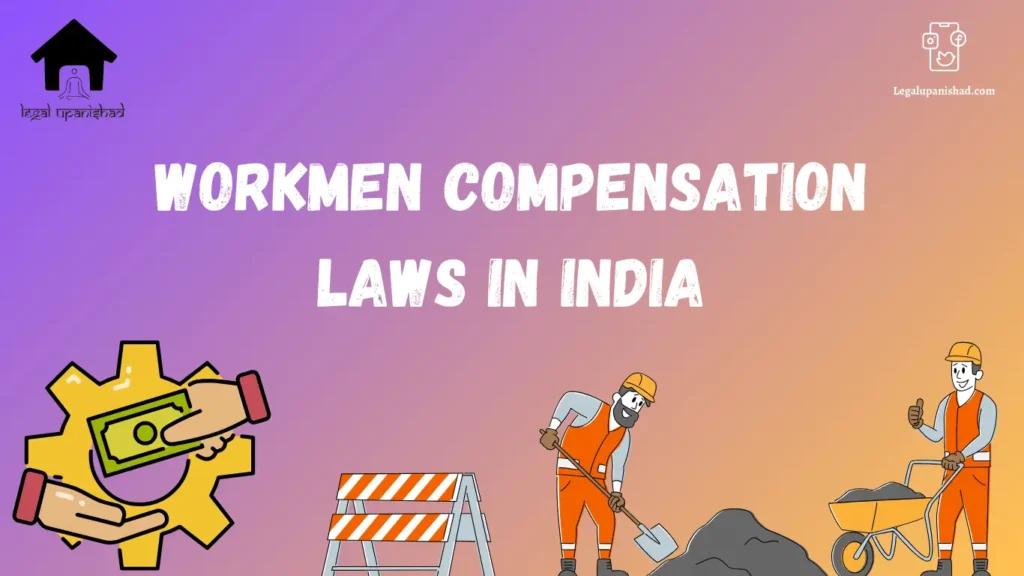This article on ‘Workmen Compensation Laws In India: All You Need to Know’ was written by Samriddha Krishna Behera, an intern at Legal Upanishad.
INTRODUCTION
Workmen compensation regulations are critical to protecting the well-being of the labour force in India. These regulations are intended to safeguard workers suffering financial hardship as a result of work-related illnesses or diseases. While encouraging a happy relationship between employers and employees, the regulatory structure guarantees that employees receive proper salaries and medical benefits.
This article dives into the fundamentals of India’s workers’ compensation legislation, including developments, benefits, and issues. Workmen’s Compensation Laws in India, officially known as Employees’ Compensation Laws, are a series of laws meant to offer economic and medical assistance to employees who are injured or get occupational illnesses while at work. These laws seek to protect the working class’s well-being and social security by requiring companies to pay their employees or their dependents in the event of workplace incidents or fatalities.
The fundamental goal of these regulations is to shift the responsibility for occupational accidents or diseases from employees to employers. This implies that employees are entitled to reimbursement for injuries sustained without having to establish employer negligence, in accordance with the idea of ‘no-fault responsibility.’ The regulations encourage a fair and reasonable work environment by resolving compensation claims in a timely and efficient manner, avoiding the need for protracted and costly court battles.
The article looks into the full structure of India’s Workers Compensation Laws, illuminating its historical context, important sections, and relevance.
HISTORICAL BACKGROUND
Workmen’s compensation rules in India date back to the late nineteenth century, when British colonial authorities enacted the Employers’ Liability Act of 1880. The purpose of this Act is to compensate workers for injuries experienced while on the job. Following that, additional labour-related laws were passed, resulting in the Indian Workmen’s Compensation Act of 1923 (renamed the Employees’ Compensation Act in 2010), and that is still the primary law controlling this subject today.
MAJOR ASPECTS OF WORKMEN COMPENSATION:
Workmen’s Compensation Laws in India consist of the following major aspects:
- Coverage: The rules apply to certain dangerous jobs or businesses, which include factories, mines, building sites, and transportation services, among others.
- Compensation is determined by the severity of the damage or impairment, the employee’s typical monthly wages, and other relevant considerations. Arrangements for dependents are also provided in the event of death.
- Insurance: Employers must get workers’ compensation insurance coverage to cover their obligations to employees.
- Employers must notify their employees concerning their rights under the Act and keep precise documentation of incidents, injuries, and compensation received.
Workers’ compensation laws are critical for offering a layer of protection for employees and their loved ones, as well as ensuring that they do not encounter financial troubles as a result of workplace injuries or illnesses. These regulations contribute to a peaceful relationship between employers and workers and promote workplace safety, which helps both the workforce and the wider economy by offering benefits such as social security and legal protection.


THE EMPLOYEES’ COMPENSATION ACT OF 1923’S KEY PROVISIONS
- The Act applies to employees who work in hazardous jobs or industries such as manufacturing plants, mines, building construction, and transportation services.
- Employer Liability: The act requires employers to pay their employees for injury or death caused by accidents that occur throughout the course of employment.
- Compensation depends on the degree of severity of the injury, the employee’s typical monthly wages, and other pertinent variables. In addition, the act specifies measures for dependents in the event of the employee’s death.
- Employers must notify employees about their rights under the Act and keep accurate documentation of accidents, injuries, and compensation awarded.
- Employers must get workers’ compensation insurance coverage to protect their obligations to employees.
BENEFITS AND IMPORTANCE
Workmen’s compensation regulations in India provide various advantages and are critical for ensuring a fair and reasonable work environment.
- Social Security rules ensure that wounded or handicapped employees and their families do not go without financial assistance during difficult times.
- Legal Protection: Workers’ compensation rules shield employees from the responsibility of establishing the employer’s culpability. Compensation is granted under the premise of ‘no-fault culpability.’
- Speedy Resolution: The compensation procedure is designed to be as quick as possible, eliminating protracted court fights and allowing injured workers to receive medical treatment and financial aid as soon as possible.
- Employer-Employee Relationships: The regulations help to preserve a pleasant employer-employee relationship by providing an effective and humane compensation system.
REFORMS AND CHALLENGES
Despite their importance, workers’ compensation laws confront several challenges:
- Informal Sector: A sizable section of the Indian workforce works in the unregulated industry, where understanding of and adherence to compensation rules is frequently low.
- Delays in collecting compensation due to administrative processes can be a major concern for many claimants.
- Appropriate Protection: The Act’s protection may not extend to all industries or forms of job opportunities, leaving certain employees vulnerable.
- Consequences are insufficient: Some employers may try to avoid their duties, and consequences for noncompliance should be enhanced to discourage such behaviour.
CONCLUSION
The importance of these regulations lies in their capacity to offer prompt and adequate reimbursement to employees who suffer injuries while working or get occupational illnesses without requiring them to prove employer fault. By putting businesses on the hook for workplace accidents, these regulations encourage a feeling of accountability and responsibility throughout the corporate community, resulting in a safer work environment.
The advantages of workers’ compensation laws are numerous. During tough times, they provide social security to employees and their families, guaranteeing that health care and financial support are easily available. The notion of ‘no-fault responsibility’ streamlines the compensation procedure, permitting employees who are hurt to get assistance quickly without resorting to protracted legal fights. Nonetheless, there are issues that must be addressed. To safeguard a broader variety of employees, the reach of these regulations should be increased to embrace more industries and forms of employment.
Furthermore, ensuring prompt compensation payments and implementing severe penalties for noncompliance will improve the efficacy of these regulations even further.
Policymakers and stakeholders must work together consistently to achieve the intended impact. By collaborating, they can make well-informed choices regarding strengthening Workers’ Compensation Laws, improving employee welfare, promoting workplace safety, and protecting working-class rights. Finally, the evolution and execution of Workmen’s Compensation Laws in India demonstrate the country’s dedication to the well-being and dignity of its employees. By adhering to these rules, India may continue to progress towards a more inclusive and equal society in which the rights of workers and social security are safeguarded and respected.
LIST OF REFERENCES
- The Employees Compensation Act, 1923, India Code, available at: https://www.indiacode.nic.in/handle/123456789/17139?view_type=browse&sam_handle=123456789/2510
- Navnit, An overview on Workmen compensation Act 1923, Legal Services India, available at: https://www.legalserviceindia.com/legal/article-992-an-overview-on-workmen-compensation-act-1923.html
- Lokesh Bagra, Workmen’s Compensation Act, 1923 : Theory of notional extension under the Employees Compensation Act, iPleaders Blog, 22 June 2022, available at: https://blog.ipleaders.in/workmens-compensation-act-1923-theory-of-notional-extension-under-the-employees-compensation-act/

